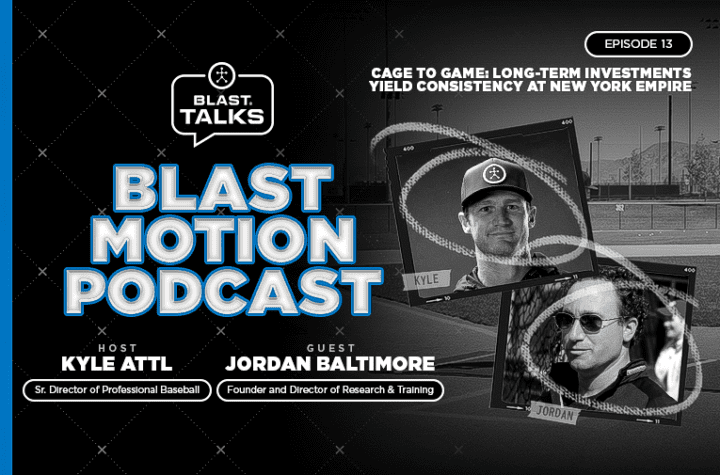
To discuss the ins and outs of an efficient baseball swing, we sat down with veteran coach and hitting instructor Rick Strickland. In addition to overseeing Sandlot Elite Baseball in St. Louis, Missouri, Strickland also serves as a pro scout and Blast Baseball Ambassador.
As the director of the most tech-prominent and progressive baseball academy in the Midwest, Rick has accumulated a wealth of knowledge, insight and experience – while helping pro players and young hitters refine and enhance their approach and execution at the plate.
We already know the value of swing speed when it comes to hitting for power and average – as well as building overall confidence as a hitter. But what about the aspect of timing and efficiency?
We’re talking about time to contact. With Rick Strickland.
Just what is time to contact? We asked Strickland this question, and his answer was equally informative and interesting.
“Everybody’s looking at swing speed and efficiency,” Strickland told us. “One of the big things that we see is that most kids are in a race to see how quickly they can get to the ball – but one of the things we saw right off the bat is that they weren’t very efficient with their swing. They were getting to the ball quickly, but they weren’t in the zone long enough with their swing. They basically went with the bat down directly at the ball. Yes, we want to be quick to the ball, but we want to be quick in a fashion where the bat’s traveling through the zone the longest.”
Strickland says that at Sandlot Elite Baseball, this balance of speed and efficiency is vital to developing smart, successful hitters.
“We want to make sure the time to contact is paired to what your efficiency index is,” explained Strickland. “And all those things tie together. If time to contact is too slow or too fast, we start to look at the video and see if there are some things on the video that tell us what could be affecting that number. That’s how we look at time to contact. It’s a part of that big giant puzzle. It’s a metric that, once we figure out what that range of that player is, we’re always trying to move that needle forward and make them better and improve that number.”
Every Moment Matters
So just why is time to contact so important for hitters?
“It’s a measurement of how fast they can move some mass,” said Strickland. “You’ve got a situation where you want the ability to wait and process information as long as you can, but to also have the ability to take the bat and be able to move it in a correct path through the strike zone – as fast as you possibly can.”
According to Strickland, time to contact can be a misleading metric at times. Because it’s not just about how fast you get there – but the route you take to get there.
“It’s a race, of course, to see how fast you can move the bat through (the strike zone), with the longest possible distance you can move it through. But sometimes, you may see a good hitter who has a little bit slower time to contact – because of how long the bat stays in the strike zone. You may see a slower time to contact, but that means that bat’s traveling through the zone longer.”
When it comes to looking closer at a hitter’s swing path – and identifying an ideal swing path – Strickland uses an analogy related to another physical activity.
“When your path with the barrel of your bat is not very efficient, it’s almost like instead of walking around the sidewalk, you’re cutting across the grass to get there. What we try to do is we try to get them to stay on the sidewalk as fast as they possibly can to get to the other side.”
When it comes to improving time to contact – and taking the right route to the other side – Strickland says that certain drills can add great value and accelerate development.
“You’ve got to focus on the bat path. The bat path is critical,” says Strickland. “If you put these guys in a contest to be quick to the ball, they’re going to competitively try to win that race every single time – but they’re probably not going to do it very efficiently. So you’ve got to attack it both ways. You’ve got to attack it by path, and you’ve got to attack it by quickness.”
In addition, Strickland believes good old-fashioned strength training must also always remain a top priority.
“The other thing is kids have to have strength,” said Strickland. “We do a lot of overload, underload type of activities with the swing, so we can build some strength, and the ability to move that bat as quick as they can.”
Developing a deeper understanding and “awareness” of metrics like time to contact is doing more than helping hitters raise their games – it’s also forcing the game of baseball to evolve and grow in new directions.
Strickland sees this as a positive development for hitters, coaches and instructors, because the more you know, the less you have to guess.
“We all played somewhere where people thought that you should hold your hands in this position or that position,” said Strickland. “All of that, the ‘guessing’, put us further away from what the truth was about the swing.”
Just the Facts
To really understand the swing, a developing hitter can use a variety of tips, tactics, training and tools. Few training tools available on the market today are as versatile and valuable as Blast’s Baseball 360.
By automatically clipping video in slow-motion, and overlaying the applicable metrics, the sensor and app help hitters analyze and improve upon key hitting metrics like time to contact.
“It takes the guessing out of it,” said Strickland. “Being able to know your time to contact, bat path, efficiency index – all the things that Blast puts into the sensor are extremely important. It really takes the guesswork out of it, and it becomes more fact-based teaching.”
To Strickland, you can’t beat objective metrics, evaluation and insight. Once you absorb the information, you can fine-tune the mechanics, efficiency and timing of your mechanics and swing. When all these pieces begin to fall into place, you start building a better hitter.
“The sensors actually tell us exactly what your body’s supposed to be doing. And when you know what the body’s capable of doing and what it should be doing, it’s easy to teach a kid or a player to swing the bat the way that he needs to swing it to be successful.”













